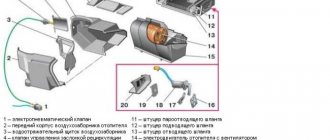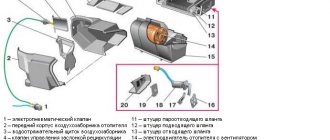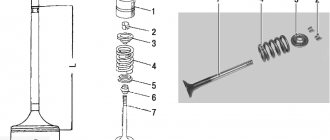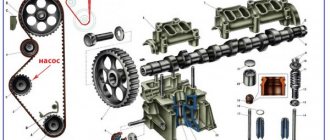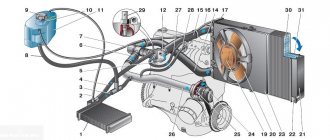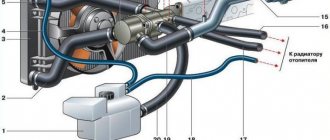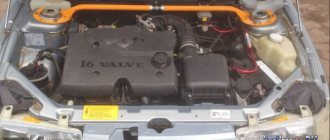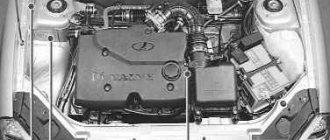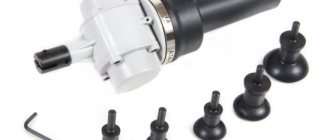Very often there are cases that, after getting into his cold top ten, the owner of this car model turns on the heater after starting the car and hitting the road. At first, the stove works and even becomes warm, but after 5 minutes it starts to feel cold again. And this situation happens quite often; after such unstable operation of the stove, the thought immediately comes to mind that the stove in your VAZ 2110 is not working.
The situation with the stove is as follows - after the car has warmed up, and also if the car is driving, then warm air blows from the stove. But it is enough to stop and cold air immediately begins to blow from the stove. If you press the gas pedal, the stove starts heating again. At the same time, there was no overheating of the engine; its temperature was normal.
With all the great love for VAZ cars, drivers understand that, despite minor features in the operation of various car systems, their generation is still significantly different. The uniqueness of the VAZ-2112 is manifested even in the heating system, which is not similar to its predecessors (except perhaps for the model above 2110). Accordingly, this also affects the features of the repair.
Why the stove in the VAZ-2112 does not heat and how to repair it correctly and efficiently is not always easy to say. Before you begin repair work, you need to understand (at least superficially) how the heating system inside the car works. It is completely electronic, which makes its function more convenient, but at the same time difficult to repair. Now the stove has three regulators that help the driver choose the temperature of the desired heating and the direction of warm air (to the feet, for example). The point is that there is a sensor on top of the cabin that regulates the air supply (by an internal damper in the stove), depending on the reaction to the temperature.
This is a very complex design, so without some knowledge in electrical engineering it is difficult to carry out repair work on your own. Not because replacing parts will be problematic. This part won't cause much difficulty. But it will be difficult to establish the source of the problem and find out why the stove does not heat as it should without a tester and an understanding of how the wiring in the car works. The only way to proceed in this case is to replace all the parts one by one in the hope that the problem will go away.
The stove doesn't blow at all, what's the problem?
If the heater fails, you can do the initial fault diagnosis yourself.
Unfortunately, the complex heater control system has not proven itself as a device that allows you to take the hassle off the driver and automatically maintain the set temperature. Instead, we got a lot of trouble and cold interiors in the frost. Let's go from simple to complex and first let's look at the problems with the electric heater motor. Everything is more or less simple here:
- Fuse. We turn on the stove, it doesn’t work. If we were lucky, the fuse had blown. Finding it is as easy as shelling pears, it is more difficult to find out the reason for its burnout. 25 amp fuse F18 is located in the main mounting block, it also protects the glove compartment lighting circuit, rear window heating and is partially related to the cigarette lighter, so it is easy to diagnose its failure. And in order to find the short circuit that caused it to burn out, you will have to call all these circuits - the glove compartment light, the rear window heating, the headlight washer and the cigarette lighter.
Heater fuse location.
- Contacts. A very common occurrence on the VAZ 2110 is the lack of contact on the heater control unit or on the electric motor itself, there is no contact on the power wire on the automatic control system. You will have to go through and clean all these contacts.
We check the contacts on the heater control unit and the electric motor.
- Stove blower. The electric motor of the stove also does not last forever and can either simply burn out or fail for another reason. To check its operation, we get to its power supply contacts and measure the voltage. If we record 12 V at the engine input, the problem is in the engine. The brushes may be worn out or burnt, the motor commutator may have burned out, or the winding may have burned out or shorted out. In any case, no one will bother with it, we’ll just replace the electric motor with a new one.
Video about replacing the VAZ-2110 heater motor
Checking the automatic heater control system
The stove control system can also give out surprises. They consist in the fact that one of the speeds may not work, several, or only one, the most powerful, may work. At the same time, the SAUO block is not universal and is selected depending on the year of manufacture of the car:
One of the reasons for the failure of the stove may be the unit of the automatic heater control system.
- 2110-8128020-03, price 2300 rubles, applies to the last ten years of production;
- 21102-8121020, price 3100 rubles, installed on cars with air conditioning;
- 2110-8128020-02, about 2 thousand, were put on the first ten years of production;
- 2110-8128020-01, 1840 rubles, used on some cars until 2000.
Nevertheless, the design of all units is similar, only some parameters are different, and the signs of malfunction are similar for all.
Reasons for stove failure
Experience shows that the causes of stove failure can be different, since the heating system has several complex components. Among the most common problems, experts identify:
- work in only one temperature mode and no speed settings;
- jamming of the heater dampers responsible for air distribution;
- failure of the temperature sensor;
- clogged air ducts;
- problems with the controller of the automatic heater control system (AHCS);
- depressurization of the system with leakage of antifreeze, especially if the stove blows cold air.
The most common problem is when the heater does not blow at any speed; as a result, there is no heating in the car at all, and the heater needs to be repaired.
Common stove malfunctions and options for eliminating them
Owners of tens often encounter a problem when the heater in the vehicle does not heat well or has stopped working. With the onset of cold weather, you have to sort out the car’s heating system and look for the causes of malfunctions.
We recommend: How to determine tire wear
Finding the original source of the problem is not always very easy. Sometimes, in order to find and fix a problem, you have to check almost all parts of the vehicle’s heating system.
Parts of the heater of the VAZ-2110 car
To make troubleshooting easier, we will consider the main indicators of improper functioning of the stove, possible sources of malfunctions in each specific case and options for eliminating them.
Supplying a weak air flow into the car interior
Owners of VAZ-2110 cars are often faced with a situation where both warm and cold air is supplied to the cabin, but under very low pressure. Accordingly, heating or ventilation of the interior requires significantly more time than during normal operation of the heating system. If the heater does not blow well, the cause of this malfunction may be a clogged heater radiator or vehicle cabin filter.
First, you need to check the condition of the cabin filter of the car. In dozens, it is most often located behind the glove compartment on the passenger side. If it is heavily polluted, then air flows through it poorly and provokes problems with the interior heating system. Contamination of a car's cabin filter can be eliminated in two ways. The first is high-quality cleaning of the filter and installing it in its original seat. However, this method is less effective. The problem will reoccur a few weeks later. A more correct solution is to replace the cabin filter with a new product. Moreover, the filter must be changed every fifteen thousand kilometers or twice a year.
Cabin filter of the VAZ-2110 car, requiring replacement
If after replacing the cabin filter the problem does not disappear, then you need to check the condition of the heater radiator. This is more difficult to do, since you will have to disassemble almost the entire heater from the engine compartment side. Poor flow of coolant in the radiator can be caused by both small particles of debris that can get into it, and the formation of scale inside the product. Antifreeze leakage through holes in the radiator may also be the reason for poor operation of the stove.
If the radiator is clogged with debris or scale, the problem can be eliminated by washing the product with special means. If there is a coolant leak, experts advise immediately replacing the radiator with a new part. Fixing the problem by soldering the radiator will help solve the problem for a very short period of time, after which the antifreeze will leak out again and you will have to re-disassemble almost half of the engine compartment to install a new part. It is also necessary to immediately check the condition of the hoses and pipes that go to the heater radiator and, if necessary, replace them.
The VAZ-2110 stove blows cold air
Often, owners of domestic cars are faced with a situation where only cold air enters the cabin through the heater deflectors, regardless of the temperature setting. In most cases, the heater blows cold air after replacing or adding coolant. The cause of this malfunction is air entering the heating system of the vehicle.
If the coolant is replaced incorrectly, an air lock forms in the radiator pipes and hoses, which must be eliminated. This is not difficult to do. It is necessary to drive the car onto a hill or overpass, so that its front end is as high as possible. After this, you need to let the car idle for several minutes, periodically you need to gas it. In this way, the air lock can be expelled from the system.
Then you need to check the antifreeze level and, if necessary, add it to the required level in the expansion tank. Often, after carrying out such actions, the stove begins to work properly.
The temperature in the VAZ-2110 cabin is not regulated
Sometimes there are situations when the heater cannot be adjusted. Regardless of the position of the temperature regulator on the control panel, the stove either blows cold air or produces only a hot stream. Such discomfort may be caused by a malfunctioning temperature sensor or a failure of the heater damper.
You can check the operation of the sensor by turning the temperature regulator several times to the extreme maximum position. If the situation has not changed, then it is necessary to replace the sensor, which is located on the ceiling of the car, next to the ceiling light.
Temperature sensor in the passenger compartment of a VAZ-2110 car
Sometimes the VAZ-2110 stove does not heat up or only works at maximum speed due to a failure of the heater damper. In this case, it is necessary to remove the deflectors from the engine compartment, bend the fastening antennae and get to the valve. Often the damper gets stuck in one position, and it does not respond to the regulator inside the cabin. Then you need to try to move the stuck part. If it moves without effort, then the problem must be looked elsewhere.
The cause of the malfunction may be deformation of the damper due to high temperatures. Then it is necessary to replace the plastic valve that the car is equipped with from the factory with a more reliable aluminum part.
The heater damper micro-reducer may also be the culprit of the malfunction. If it fails, it will be impossible to adjust the temperature in the cabin. You can check this by removing the windshield trim and frill from the engine compartment. After this, it is necessary to test the movement of the damper lever when switching heater modes in the cabin. If the damper lever moves, then the micro-gearbox is working. Otherwise, it must be replaced.
If the VAZ-2110 stove does not work in any mode other than the maximum one, then the cause of the breakdown may be a failure of the heater resistor. The resistor may fail due to overvoltage in the network. The resistor is located on the right side of the stove. To replace it or diagnose it, it is necessary to dismantle the windshield cover and the vacuum booster. After this, using an ohmmeter, the resistance on the coils, which are responsible for converting the current into the required voltage for the correct operation of the heating system, is checked. If the indicators differ from the norm, then it is necessary to replace the product with a new resistor.
And also the problem may be in the disconnection of the fuse, which is located on the resistor board. In this case, you can eliminate the malfunction by soldering, however, you must first find the cause of the blown fuse. It may be in oxidized contacts or poor wiring insulation. Initially, you need to diagnose all elements of the heater's electrical circuit using a tester, find the weak link and eliminate the malfunction. Poor operation of the heater's electrical components can cause a short circuit or fire.
We recommend: Symptoms of a faulty coolant temperature sensor
The VAZ-2110 stove does not work
If the stove on a VAZ-2110 has completely stopped working, this may indicate a failure of one of the elements of the heating system. In this case, to determine the cause of the malfunction, you will have to check the functioning of absolutely all parts of the heating system. This is a labor-intensive task and requires the performer to have certain knowledge of electronics. It is also necessary to understand the technology of functioning of the car’s heating system.
Diagram of the automatic heater control system: 1 – fan electric motor; 2 – additional resistor; 3 – controller; 4 – mounting block; 5 – ignition switch; 6 – cabin air temperature sensor; 7 – recirculation switch; 8 – recirculation valve; 9 – micromotor gearbox for heater damper drive; A – to the instrument lighting switch; B – to power supplies
Most often, the VAZ-2110 stove does not work due to a fan failure. It can be easily replaced with a new product. In second place is the thermostat, which is also replaced in case of malfunction.
Failure of a vehicle's heater in most cases results in the need for major repairs. In this case, you need to calculate the possible costs of purchasing new parts and compare them with the price of a new stove. Experts recommend that if the stove fails completely, it should be completely replaced. Very often, the VAZ-2110 is equipped with stoves from the VAZ-2112 that are more advanced in design features and technical characteristics.
Heating system design
Design of the heating system "tens"
If the stove cannot turn on, it begins to blow heat poorly or has stopped producing heating altogether, you need to take a very serious approach to solving the problem. After all, operating a vehicle in the winter without a heater is the most inconvenient and uncomfortable option for a motorist. Therefore, before you learn how to remove and disassemble hoses on new and old devices and how to properly adjust the system, let's understand the device.
On domestically produced vehicles, including the VAZ 2110, the heating system has certain differences. First you need to take into account that the heating system operates separately. In particular, it is represented specifically by the heater. The heater is the stove itself.
The stove will be filled inside with a hot air flow, which enters the vehicle interior through special heat distributors - pipes. The pipes themselves are led to the car's interior, where warm air flows directly from the front center console to the driver and passenger (face and legs), as well as to the windows.
Thanks to window blowing, the driver can get rid of the problem of freezing or fogging. The entire system is controlled using a special regulation and control unit, which regulates the air flow and temperature conditions. That is, in essence, this block is an air flow distributor. Unlike other domestically produced car models, the stove on the “ten” has a fundamental difference - it is equipped with an evaporator (the author of the video is Alexander Amochkin Kolomna AAK).
The design of the heating system of the VAZ-2110
The concept of interior heating on the VAZ-2110 remains the same - the air supplied to the cabin is heated by the cooling system. To do this, a radiator is installed in the cabin, under the front panel, which is included in the cooling system; heated antifreeze moves through it. The air passing through the radiator is supplied through the air intake. After heating, the air flow through the air ducts is supplied to the necessary areas - the windshield, legs, torso.
Forced air circulation is provided, which increases the efficiency of the distribution of warm flow throughout the cabin. For this purpose, the stove is equipped with a fan driven by an electric motor.
The air heating temperature is regulated by dampers. One of them allows the flow either through the radiator (for heating) or bypassing it. The damper divides the flow to obtain the desired temperature - one part of it goes through the radiator, and the second bypasses it, after which it is mixed, the degree of heating is regulated and supplied to the air ducts.
The second damper is designed to shut off the air supply to the cabin from the outside. Thanks to it, a closed air circulation mode is established.
Checking the dampers of the VAZ 2110 heater system
The stove system has 2 dampers. The upper one regulates the intake of cold air, and the lower one regulates the intake of hot air from the heater radiator. And when the drive mechanism or the damper itself breaks down, the stove can heat weakly, not heat at all, or fry too much.
Breakdowns of the heater damper can be of different types; firstly, the damper often gets stuck or jams , and secondly, the damper drive (micromotor-reducer) fails . In some cases, the damper warps or jams due to rust , since there are two types of dampers: the old and the new type, the old ones are plastic with a foam rubber seal, and the new one is metal with a rubber seal. Therefore, if you cannot hear the damper moving, you can move it by hand by removing the deflector in the central panel. The problem with metal ones is that they often jam from rust, and plastic ones warp from exposure to hot air. So if, for example, warm air blows into the front window of a VAZ 2110, and hot air blows from the sides and into the legs, then most likely the damper has not completely blocked the air intake from the street. And when the dampers do not move at all, then you need to check the microdetector - the damper drive mechanism.
Refinement of the plastic block
If the stove blows weakly into your feet, then the reason is the plastic heater control unit of the VAZ-2110. Before starting repairs, it is recommended to make sure that the stove is in working order. Then you will need:
- dismantle and disassemble the torpedo;
- seal the cracks on the panel;
- install a new corrugation;
- seal the panel.
During the factory assembly of the car, the damper is poorly pressed against the dashboard, which contributes to the loss of hot air in the instrument panel. This problem can be solved by removing the damper and the standard seal. We treat the cracks and the valve with madeleine. The factory sponge is replaced with Bitoplast-10. To prevent the passenger's feet from freezing, the air ducts are being modernized.
Another heat loss problem is related to cracks near the driver's seat. They can be blown out with foam. If necessary, replace the old-style air distributor. We place a pipe with a diameter of 40 mm in each hole. If the unit works correctly, then the heating scheme is as follows: from one corrugation warm air flows to the driver’s feet, and from 2 and 3 to the passengers’ feet. There should be no holes between the pipes. If you completely remove the air ducts, hot air will flow into the cabin.
The VAZ 2110 stove does not work: reasons
And the reason that the VAZ 2110 stove does not work is quite simple - change the antifreeze if it is very old and dirty in the radiator. Therefore, in order for the stove to work as it should, the first step is to flush the radiator, add new antifreeze or antifreeze, and the stove will work great.
But there are also unique cases when, after replacing the antifreeze and cleaning the radiator, the problem does not disappear and the VAZ 2110 stove does not work as before. By the way, in the VAZ 2111 and VAZ 2113 the situation may be similar.
In this case, you need to find a light bulb that shines in the cabin; if you open it, there will be a cabin sensor, which is blown by a compact fan. This sensor must be turned off, then the stove will definitely work.
But while driving, the problem with the stove may return again in just a couple of days. And the whole root of the problem lies in the stove control unit, which is faulty. You just need to change it. After replacing the control unit, the cabin will be warm thanks to the smooth operation of the stove.
Therefore, if the stove does not work in your VAZ 2110, there may be the following reasons why it does not work:
- presence of air in the cooling system;
- faulty thermostat;
- faulty control unit;
- dirty cabin filter;
- faulty interior temperature sensor;
- dirty or broken furnace radiator;
- contaminated engine cooling system.
Therefore, in order not to waste a lot of time yourself, you can immediately go to a car service, where they will immediately find out what is the cause of the breakdown and fix it. In general, it’s better not to save money on stove repairs, because in winter it’s very uncomfortable without a stove, and your health can be ruined.
We recommend: Carburetor design
And then a video about how to change the stove on a VAZ 2110 or a VAZ 2115, it has a similar design:
We fix heater malfunctions on a VAZ 2110
This question worries many car enthusiasts, especially when the first severe frost and dank damp weather clearly remind us of the coming of winter. I also faced the same problem. The heater in my car either didn’t heat up at all or only warmed up very poorly.
Well, when instead of the expected warmth cold air blew out of it, my patience ran out. I decided that I needed to get rid of this problem as soon as possible, otherwise in severe frost you won’t be able to get far in such a car. How did I manage to repair the stove? Very simple. The accumulated knowledge plus a little experience, which I now share with you. I hope that my recommendations will help you repair your heater and avoid freezing in winter. Now let's take a closer look at what problems can arise with the heater if the radiator is working. If there is a problem with the controller, the easiest way to troubleshoot the stove is to replace the old part and test it in action. The whole job will take you no more than five minutes.
If the micromotor-gearbox breaks down, you will have to tinker a little. Here it is necessary to remove the engine soundproofing shield and the frill.
Cold air
If the VAZ 2110 stove stops working and cold air is blowing out of it, then the breakdown may lie in a faulty interior sensor on the ceiling. Now I will explain the principle of operation. When the sensor is disconnected, the micromotor reducer receives a signal different from the temperature in the stove. This is why the fan stops working in high-speed “A” mode.
If the damper moves only in the extreme positions, given that the temperature sensor is disabled, there may be two reasons for the malfunction:
- Controller temperature sensor malfunction.
- Micromotor sensor malfunction.
The failure may have occurred due to the fan. It is installed on the temperature sensor. Check if it rotates at the MIN and MAX positions. To do this, simply apply 1.2 V to the terminals. How to check the controller? To do this, turn on the ignition. Rotate the temperature knob and measure the voltage on the long connector. This will be the pink and brown wires.
If your vehicle has a pre-2001 controller, the voltage should drop after approximately 13 seconds. Maybe a little less or more. The reduction occurs in the min position. In the max position, the voltage is supplied continuously. If the controller is a new model, then after 13 seconds of operation in both modes it will simply turn off. If the voltage remains unchanged at the output, then this part is faulty.
Damper
The reason why the stove on a VAZ 2110 with an injector does not work may be a faulty damper. The heater has two dampers - upper and lower. The upper one controls the flow of cold air, and the lower one controls the flow of hot air. This problem can be easily fixed. In old-style stoves, the damper is made of plastic. It has foam seals. In new heaters, the dampers are metal and have rubber seals.
If, when you move the damper, you hear a rumble and cold air blows from the stove, then the damper may be broken or its drive has failed. If there are cracks or splits on the plastic flap, they can be glued together with dichloroethane. The metal flap is quite difficult to break, but it can easily jam. It often gets stuck due to rust. If this was the problem, I would advise you to paint it. This will solve the problem.
This concludes the description of all possible options. I am the owner of a dozen and here I described in detail my actions during the last stove breakdown. She took a lot of patience from me. But I feel sorry for the swallow. And I want to ride in comfort in winter. I hope my advice will help you troubleshoot all problems. Return to top
Other causes of failure
- In addition to the dampers, the fan often starts to malfunction. Possessing as many as four operating modes, its malfunctions can be very different. The first thing you need to do is look at the fuse (F7). If the fan refuses to work at all, most likely this is the problem.
- There are times when the above-mentioned unit performs poorly or even stops rotating at low speeds. This problem is more complicated, since, most likely, it is associated with the burnout of additional resistance. This is not that difficult to fix, but the problem will be the path to solving such a problem. The broken part can only be reached through the engine compartment.
- In addition, it is in the engine compartment that you often need to look for the reasons why only warm air comes out, while the adjustment is at the “maximum” position.
It's all about adjusting and supplying air inside the car body. The climatic conditions outside the car are also important to consider. But it’s better to leave all the troubles with the engine compartment in the hands of the service station. Repairing heaters, stoves, and air circulation in this machine is very difficult, so independent work must be carried out with a great understanding of responsibility and good experience in machine repairs.
Fan replacement
If the problem still lies in the fan itself, then it would be best to replace it with a new one. The stove fan can, of course, be repaired, but this may involve, for example, replacing the brushes. It simply doesn’t make sense to carry out more comprehensive repairs, since you can’t hope for long-term service for such a part. Replacing a VAZ-2110 stove fan requires selecting a new part. There are two options here: find an old-style part or buy a new spare part. The second option is more acceptable and accessible.
VAZ stove fan
The replacement process is not as complicated as it might seem. It is enough to be able to work with standard tools, have free time and have the desire to tinker with your own machine. To replace a faulty fan, you must follow the following work plan:
- Open the hood and remove the battery negative terminal.
- We remove the windshield wipers by prying and dismantling the rubber caps. Using a 10mm wrench, unscrew the nuts and remove the brushes.
- Using a slotted screwdriver, pry up the decorative plugs, unscrew the screws on the frill and the nuts on the edges. Now we can remove the frill.
- Under the rubber seal you can find screws that hold the shield from the engine compartment. We also unscrew them.
- We dismantle the hose through which washer fluid is supplied to the injectors.
The process of replacing a fan is not as complicated as it seems
- On the right side of the engine compartment, there are two nuts on the bottom side that fit a 10mm socket wrench. They are difficult to get to, but you don’t have to unscrew them all the way, because with a few turns the shield can be easily removed.
- It is necessary to remove the clamps from the hose that connects to the vacuum booster of the brake system in advance.
- There are four self-tapping screws on the cabin filter cover; after unscrewing them, you can easily remove it.
- Already at this stage the outlines of the stove motor are visible. But you will also need to disconnect the block on the heating system motor and on the resistor.
- After the work has been done, it becomes possible to dismantle the left side of the stove along with the motor.
- A new part is installed in place of the damaged element, and assembly is carried out in the reverse order.
If you have never had to remove a heating system fan before, this process may take several hours. But in the future, any problem with the heating system can be fixed much faster. Even if something doesn’t work out for you during your work, you don’t need to stop trying to achieve a positive result. Over time, everything will definitely work out.
The heater only blows at one speed
Without dismantling, you can diagnose a breakdown if the fan spins only at one speed or only in the third mode . The reason is the resistor, which is installed in the heater controller itself.
When the stove operates at only one speed, you should check the resistor.
Structurally, the switch is designed so that in the first two modes the electric motor is supplied with low voltage through a resistor, and in mode 3, bypassing the resistor. You can check this using a multimeter in resistance measurement mode.
The resistance of the first speed resistor is 0.23 Ohm , the second is 0.82 Ohm . If the spiral breaks or the contact tracks are worn, the multimeter will show infinity or a break.
Depending on the controller model, it may have three or four control positions, but the principle of operation is the same and understanding the connection diagram is not so difficult. Whatever the switch is, if speeds 1 and 2 are not working, you need to check the resistance on the switch slider . Thus, you can try to restore the heater control system or replace it with a new one as a last resort. Good luck to everyone in their search and warm cozy salons!
Video about the reasons why the VAZ-2110 stove does not work
Let's sum it up
The high-quality functioning of the heating system of a vehicle is the main factor that affects the comfort and convenience of the interior. Problems with its operation during the cold winter periods force drivers to carry out urgent repairs and checks of the heating system.
There can be many reasons why the VAZ-2110 stove does not work or does not heat well. The main thing is to understand the technical features of the car’s heating system in order to narrow down the search for a fault as much as possible. Almost all dozens of causes of poor-quality interior heating can be eliminated with your own hands without significant financial investments.
To prevent heater breakdowns at inopportune times, monitor the car’s heating system and carry out regular preventive inspections and diagnostics. Experts recommend diagnosing the vehicle heating system at least twice a year. Only proper operation of the heater and constant high-quality care of it will guarantee its uninterrupted operation at any time of the year.
Diagnostics of heater system shutters VAZ 21I0
The VAZ 2110 stove has two shutters.
Through one, cold air is absorbed, and through the other, hot air is supplied. If the wire mechanism malfunctions, you may encounter the following disadvantages:
- The stove doesn't heat well
- There is no hot air flow at all,
- high air supply temperature,
- temperature is not regulated.
Shutters can have various types of breakdowns:
- It happens that the damper gets stuck or malfunctions, and the micromotor gearbox can also fail.
- Also, the damper may stop functioning due to rust, because there are two types of dampers.
There are old and modern samples of shutters,
- old ones - made of plastic and sealed with foam rubber,
- and modern ones are made of metal with a rubber seal.
If you cannot hear the damper operating, then try moving it after removing the deflector.
The disadvantage of metal dampers is that breakdowns often occur due to rust, while plastic ones tend to deform due to the supply of hot air.
In the case where the shutters do not move at all, diagnose the microdetector.
Principle of operation
The operating principle of such a control system is simple - the driver uses the left handle to set the desired temperature (completely cold or in the range from 16 to 28 degrees). Based on the set mode, the controller supplies power to the micromotor gearbox and it sets the dampers to the desired position.
Two-way communication is used between these elements - a position sensor is installed on the gearbox, which “informs” the controller about the opening angle. Thanks to the installed temperature sensor (located on the ceiling), the controller constantly monitors the degree of heating of the air in the cabin, based on which it adjusts the position of the damper to maintain the temperature set by the driver.
Temperature sensor VAZ 2110
Thanks to the use of automatic control system, the driver no longer needs to adjust the operation of the stove in order to maintain a comfortable temperature; he sets the temperature with a handle, and the controller does the rest. On the early VAZ-2110, the heater fan had three operating modes, the difference between which comes down to the rotation speed. Speed adjustment is carried out by installing a rheostat block in the power supply circuit of the electric motor. Then models appeared in which the fan received a 4th operating mode - automatic. When it is turned on, the fan operates under the control of the controller - the ACS regulates the rotation speed of the electric motor to adjust the temperature in the cabin.
The use of electromechanical control on the VAZ-2110 increased the convenience of controlling interior heating, but due to the more complex design, the likelihood of stove failure increased.
Advice from auto mechanics
To tune the VAZ heating system, its circuit diagram is studied. The system can be modified to block the air flow to the rear of the car using foam. The factory thermostat is also being replaced with an analogue one with 6 holes. In this case, the temperature in the cabin will remain longer, and the stove will heat better. Another way to modify the standard 2110 heating system is to install a plug for the deflector.
In order for the stove to serve longer, it is recommended to follow the rules of its operation.
If your car has air conditioning, it should only be turned on in wet weather. In winter, the stove turns on and directs the air onto your feet or onto the glass.
To ensure good operation of the heater, the nozzle is raised above the lining. Before starting the stove in winter, it is recommended to clean the glass from moisture.
Replacing the heater radiator on VAZ 2110 and 2112. When the resource is exhausted
- Old model (until 2003);
- New model (since 2003).
- Remove the rubber seal from the wind lining;
- The fasteners are unscrewed and the frill is removed;
- Remove the windshield trim. To do this, unscrew the nuts and screws located along its edges;
- The hose is removed from the front window washer. It should be moved to the side, otherwise it will interfere with further work;
- Unscrew the wiper fastenings;
- The cover (wind deflector) is finally removed;
- The metal clips are removed from the stove body. They are examined carefully, if corrosion is visible on them, then they need to be replaced with new ones;
- Remove the filter in the cabin, which is attached to the heating radiator with screws; Turn off the fan. To do this, remove the positive connector and unscrew the nut from the negative terminal (on the body);
- Unscrew the 3 screws securing the stove cover;
- Loosen the hose clamps. We remove the radiator.
